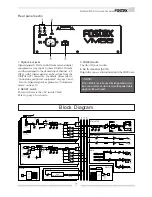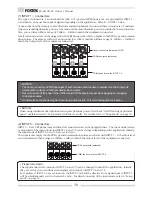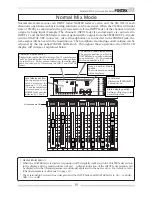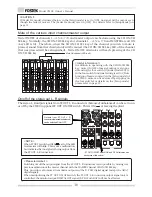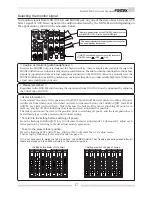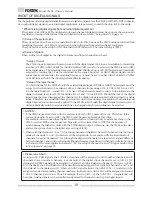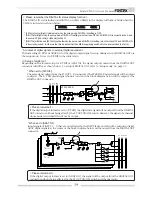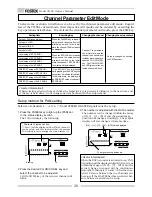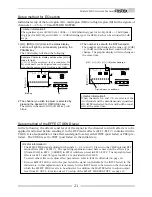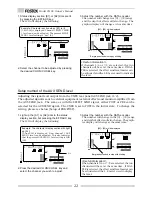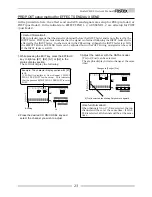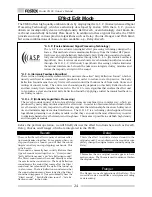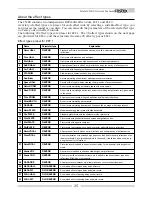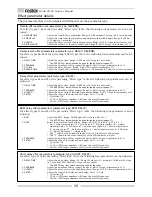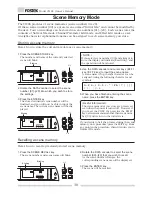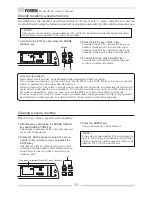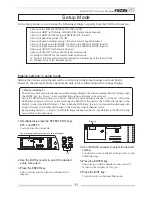
18
Model VM88 Owner’s Manual
IN/OUT OF DIGITAL SIGNALS
For the purpose of mixing digital signal from external digital equipment via the VM88 DIGITAL IN/OUT connecter
or to output digital signals to external digital equipment, it is necessary to match the objective to the setup.
* When mixing digital signals from external digital equipment
The system clock (INT or EXT) and digital in (format/channel of digital in) must be setup via the setup mode.
For details on setup of the system clock and digital in, please refer to “Setup mode” on page 33.
(1) Setup of the system clock
The system clock must be setup for operation (refer to <NOTE> below) of the VM88 using its internal clock
(sampling frequency: 44.1kHz) or operation in sync with signal from external digital equipment.
The system clock can be setup for INT (Internal) or EXT (External). The initial setting is [EXT].
(2) Setup of digital in
When setting up of digital in, the digital in format and input channel must be set.
< Please remember! >
At input of S/P DIF signals, the S/P DIF L channels will be assigned to odd number channels and R
channels to even number channels. For example, if the digital input channel is set to [CH 1/2] (2
channels), S/P DIF L signal will be assigned to channel 1 and the R signal to channel 2. If it is set to [CH5-
8] (4 channels), the L and R signals will be simultaneously assigned, the L signal to channels 5 and 7, and
the R signal to channels 6 and 8. When an ADAT signal is input, the ADAT (Ch1 ~ 8) signals will be
assigned to their corresponding channel numbers. In other words, ADAT Ch 1 will be assigned to channel
1, Ch 2 to channel 2, and so on. Thus, for example, if set to [CH 1 ~ 4], the ADAT Ch 1 ~ 4 signals only will
be input. Analog signals can be simultaneously mixed in channels not setup for digital inputs.
< NOTES >
* If the VM88 is used as a slave with the system clock set to [INT], noise will occur. Therefore, if the
system clock must be set to [INT], the VM88 must be used as the master machine.
For example, when connecting a digital recorder which can function only as a slave machine to the
VM88, use the VM88 as the master machine and set its system clock to [INT] for the purpose of
synchronizing the digital recorder with the VM88 digital output. Otherwise, use the VM88 as the slave
and set the system clock to the initial state setting of [EXT].
* When selecting channels 5/6 or 7/8 for input channels of digital in, be careful when setting the input
modes of channels 5/6 or 7/8 which are in the setup mode. For example, with the input mode of
channels 5/6 set to “monaural,” even though the digital in channels 5/6 are selected, signals different
between channel 5 and 6 will not be input although the same signal input to channel 5 will also be input
to channel 6 (The same applies to channels 7/8). For setup of channel 5/6 and 7/8 input modes, refer
to ”Setup mode” on page 33.
* Setup of format
The VM88 input format must be setup to match the digital signal to be input. In addition to formatting
to either [S/P DIF], [ADAT 48kHz] or [ADAT 44.1kHz], [OFF] can also be selected (the VM88 is set to [OFF]
in the initial state). The sampling frequency (44.1kHz/48kHz) at input of S/P DIF signals is automatically
selected by reading the FS status contained in the signal. However, as ADAT digital signals cannot
automatically acknowledge the sampling frequency, it must be set to either [ADAT 48kHz] or [ADAT
44.1kHz] in match with the input signal sampling frequency.
* Setup of the input channel
To which channel of the VM88 should the external digital input (S/P DIF or ADAT) be assigned, must be
setup. For the channels to be assigned, either 2 channels from among CH 1/2, CH3/4 CH 5/6 or CH 7/
8, 4 channels from CH 1 ~ 4 and CH 5 ~ 8 or ALL CH for 8 channels, must be setup. In the initial state, the
digital in format is set to ALL CH for ADAT 48/44.1 and 7/8 for S/P DIF. Should the lock of the digital
input signal become disengaged, the channel set for digital input is automatically switched to analog
input. Therefore, in a situation where you cannot redo, such as during a live session, if both analog and
digital inputs are simultaneously applied to the VM88, even though the digital signal is interrupted, it
will automatically switch to analog and thus a lost opportunity for recording can be avoided.




